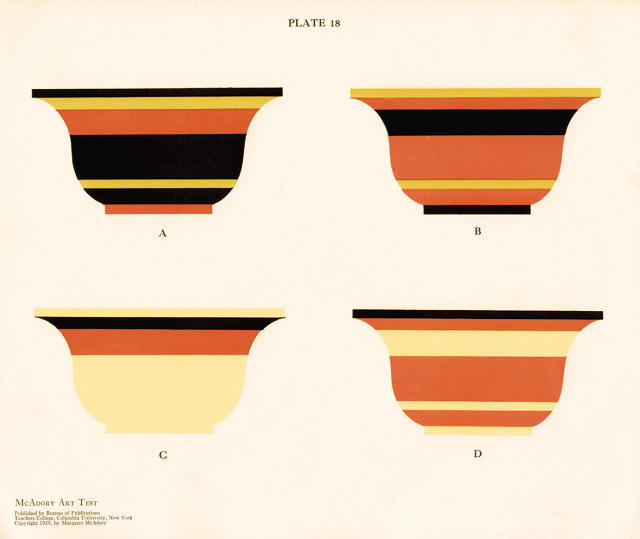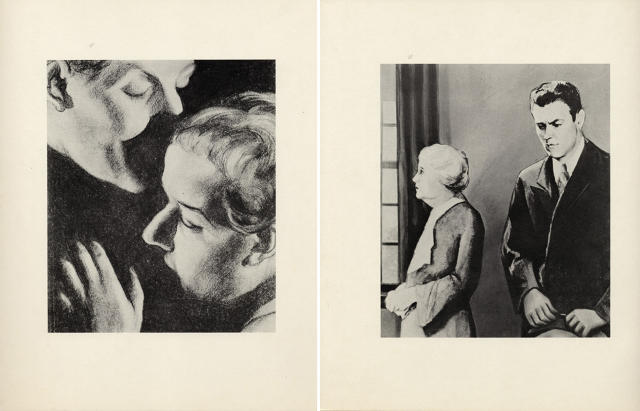If your psychotherapist turns up with one of these, make an excuse and leave.
Most of us are familiar with Rorschach inkblots as a tool psychologists use to test patients' personality and emotional well-being, but that's just the tip of the iceberg. In his new book, Psychobook (Princeton Architectural Press), art historian and critic Mel Gooding examines some of the other designs that 20th-century shrinks used to get inside their patients' heads, and there are some real doozies in there. Here are four tests we're glad psychology has moved beyond.
Szondi Test

Most psychology tests are, in their own way, based upon the idea of interpretation: namely, a doctor prompting a patient with ideas and objects, then interpreting what those responses mean. Few psychology tests, though, have ever taken it to such offensive extremes as the Szondi test. Invented by Hungarian psychiatrist Léopold Szondi in 1935, the test presented six sets of photographic portraits to patients, who were asked to classify these "psychopaths" into eight different categories: homosexual, sadist, epileptic, hysteric, catatonic, paranoid, depressive, and maniac. A patient's choice supposedly reveals the true nature of the patient's own personality, ranked upon Szondi's equally bizarre Drive system. "If your psychotherapist turns up with one of these, make an excuse and leave," jokes Gooding.
The MacAdory Art Test

Want to know if your kid has the sensitivity and aesthetic eye to be an artist? This test, designed by Margaret McAdory in 1933, purported to do so, according to psychology! The test was simple: a subject was shown a collection of four objects—a vase, a spoon, etc.—then asked to identify the best design. Oh, you're going to pick that one, hmm? Are you sure? BZZZZT. Wrong! Forget your scholarship to RISD, kid, you're clearly not cut out for a career in the arts. Gooding says that what's particularly strange to him about the test is how good all of the designs are. "Some of them have a pop art or conceptual aesthetic," he says. "They're all quite interesting. But MacAdory's test [claims] there's only one right answer to any question of art, which we, as modern people, know simply isn't true."
The Thematic Apperception Test (TAT)

A variation on the Rorschach test, the TAT (thematic apperception test) was created by American psychologist Henry A. Murray and psychoanalyst Christiana D. Morgan at Harvard during the 1930s. Subjects are encouraged to look at a series of pictures and describe the story they tell; the story is then analyzed. (Side note: the TAT was apparently inspired by a famous chapter in Moby Dick in which the entire crew of the Pequod interpret the symbols in a doubloon as an extension of themselves.) Critics call the TAT wildly unscientific, as the interpretations psychologists make cannot be proven or disproven, but Gooding points out another problem with them: The images used in the 1930s TATs are totally nightmarish. In one, an old crone leers over the shoulder of an androgynous young woman or man. In another, a man is seized violently in the dark. "They can be very sinister in their own way," Gooding notes. Today, many professionals still use TATs, although not necessarily with these designs: The only requirement is that the images be both provocative and ambiguous.
Pictorial Completion Tests

Created in the 1920s by Chicago child psychiatrist and criminologist William Healy, this test looks, at first, pretty benign. Children are supplied a scene of a bunch of people doing things, but with all objects removed. A child is then tasked to place tokens representing those objects where they are supposed to go. For example, a little girl feeding a saucer of milk to a cat, or two little boys kicking a football back and forth. So far, so good. But inevitably, some kid is going to think it's funny to make those kids kick a cat back and forth, instead of a football—which is just what the Pictorial Completion Test was designed to detect. Healy believed that his Pictorial Completion Tests could detect "defective or aberrational" tendencies in children that would lead to signs of juvenile delinquency and future criminal behavior.
Conclusion

Although some of these tests are obviously outdated or offensive to modern eyes, Gooding says that they, and others in Psychobook, all have merit, at least to historians. "Freud published his Interpretation of Dreams in 1899, so I think it's fair to call the 20th century the Age of Psychology," he says. "All throughout the century, you just see a huge increase in people's fascination with what makes us all tick, resulting in this just fantastic accumulation of materials to test and to investigate." Reading Psychobook is like taking a whirlwind tour through the Age of Psychology, as seen through the visual designs that the headshrinkers left behind.